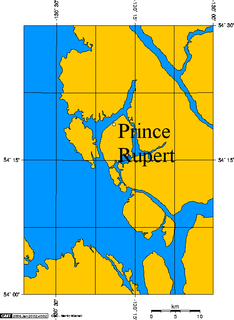
Prince Rupert is a port city in the province of British Columbia, Canada. Located on Kaien Island, Prince Rupert is the land, air, and water transportation hub of British Columbia's North Coast, and has a population of 12,220 people.

The Prince Edward Island Railway (PEIR) was a historic Canadian railway on Prince Edward Island (PEI). The railway ran tip-to-tip on the island, from Tignish in the west to Elmira in the east, with major spurs serving Borden-Carleton's train ferry dock, the capital in Charlottetown, Montague and Georgetown and the original eastern terminus at Souris. A major spur from Charlottetown served Murray Harbour on the south coast.
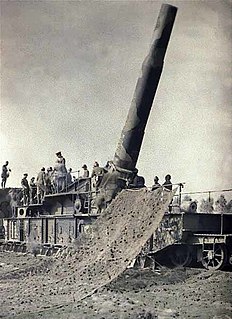
A railway gun, also called a railroad gun, is a large artillery piece, often surplus naval artillery, mounted on, transported by, and fired from a specially designed railway wagon. Many countries have built railway guns, but the best-known are the large Krupp-built pieces used by Germany in World War I and World War II. Smaller guns were often part of an armoured train. Only able to be moved where there were good tracks, which could be destroyed by artillery bombardment or airstrike, railway guns were phased out after World War II.
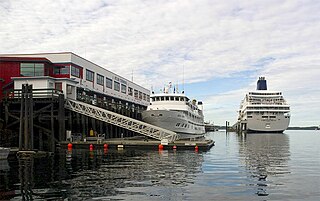
The Prince Rupert Port Authority (PRPA) is a port authority operating under the Canada Marine Act as an autonomous and commercially viable agency. PRPA has responsibility for all federally owned waterfront properties on Prince Rupert Harbour, located in and around the city of Prince Rupert on the North Coast of British Columbia.

Coastal artillery is the branch of the armed forces concerned with operating anti-ship artillery or fixed gun batteries in coastal fortifications.

Naval Station Argentia is a former base of the United States Navy that operated from 1941 to 1994. It was established in the community of Argentia in what was then the Dominion of Newfoundland, which later became the tenth Canadian province, Newfoundland and Labrador.
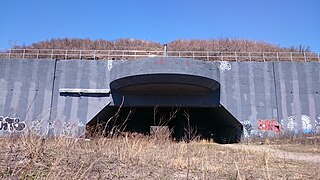
Fort Tilden, also known as Fort Tilden Historic District, is a former United States Army installation on the coast in the New York City borough of Queens. Fort Tilden now forms part of the Gateway National Recreation Area, and is administered by the National Park Service.

The Dover Strait coastal guns were British and German long-range coastal artillery pieces, on the English Channel coasts of Kent, England and the Pas-de-Calais, occupied France. The Strait of Dover is the narrowest channel between England and continental Europe. During the Second World War, both sides used their guns to bombard shipping in the Channel as well as coastal towns and military installations.

The HeughGun Battery is located on the Headland at Hartlepool, County Durham, England.
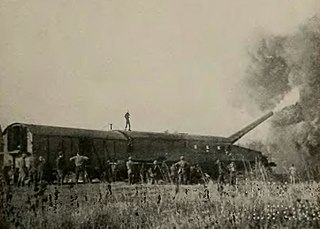
The 14"/50 caliber railway guns were spare US Navy Mk 4 14 inch/50 caliber guns mounted on railway cars and operated by US Navy crews in France in the closing months of World War I.

Culver Battery is a former coastal artillery battery on Culver Down, on the eastern side of the Isle of Wight. The fortification is one of several Palmerston Forts built on the island following concerns about the size and strength of the French Navy in the late 19th century. It was operational during the First and Second World Wars. The battery was closed in 1956.
Barrett Point is located at the foot of Mount Hayes at the entrance to Prince Rupert Harbour at 54°14′28″N130°20′02″W. It was a coastal fortification during World War II.

The Prince Rupert station is on the Canadian National Railway mainline in Prince Rupert, British Columbia. The station is the western terminus for the Via Rail's Jasper – Prince Rupert train.

The 8-inch gun M1888 (203 mm) was a U.S. Army Coast Artillery Corps gun, initially deployed 1898–1908 in about 75 fixed emplacements, usually on a disappearing carriage. During World War I, 37 or 47 of these weapons were removed from fixed emplacements or from storage to create a railway gun version, the 8-inch Gun M1888MIA1 Barbette carriage M1918 on railway car M1918MI, converted from the fixed coast defense mountings and used during World War I and World War II.
28th Anti-Aircraft Brigade was an air defence formation of the British Territorial Army created in 1925 to command anti-aircraft units in Kent and around the militarily important Medway Towns, which it defended during the Second World War. In 1940 the brigade was responsible for the defences on the south side of the Thames Estuary including the Royal Naval Dockyard at Chatham and the Port of Dover. The brigade was heavily engaged throughout the Battle of Britain, in the summer of 1940, and The Blitz, from autumn 1940 to spring 1941, operating a total of 70 heavy anti-aircraft (HAA) guns controlled from a gun operations room (GOR) at Chatham. During 1942 many of the brigade's experienced units were transferred to active theatres overseas. Increasingly the brigade included women of the Auxiliary Territorial Service (ATS).
HMCS Courtenay was a Bangor-class minesweeper constructed for the Royal Canadian Navy during the Second World War. Entering service in 1942, Courtenay spent the entire war on the West Coast of Canada. The vessel was decommissioned in 1945 and sold for mercantile service in 1946. The fate of the vessel is uncertain.
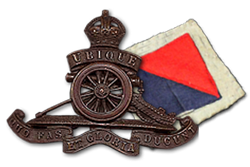
The 89th Heavy Anti-Aircraft Regiment, Royal Artillery was an air defence unit of Britain's Territorial Army (TA) raised in Kent just before the outbreak of World War II. It served during the Battle of Britain and defended the Suez Canal while batteries served in the Battle of Crete and the Siege of Tobruk. The regiment then fought through the North African and Italian campaigns.
2nd Anti-Aircraft Brigade was an air defence formation of the British Army during World War II, seeing active service in the Battle of France and the North African and Italian campaigns.

The Forth Royal Garrison Artillery and its successors were Scottish part-time coast defence units of the British Army from 1908 to 1956. Although they saw no active service, they supplied trained gunners to siege batteries engaged on the Western Front during World War I.
